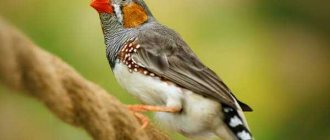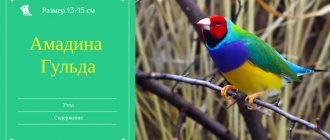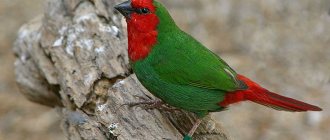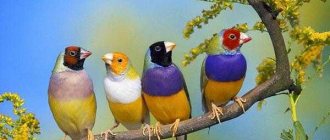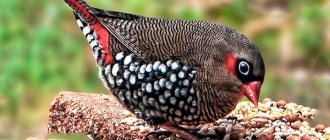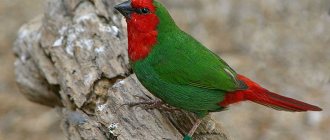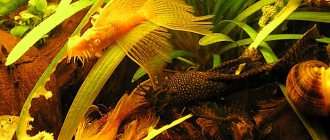- Birds
In the world, in addition to parrots and canaries, there are also birds that can bring joy to the house with just their appearance. These are finch birds. These are very gentle, sweet and unpretentious domestic companions who, when communicating with each other, produce a characteristic, interesting sound reminiscent of a duck quacking. The most ideal bird friend for a large family is the zebra finch - this is one of the varieties of finches from the family of weaver finches. For those who have decided to take up ornithology for the first time or have a cute chick, the zebra finch is the ideal bird.
Appearance of white finches
What do white finches look like? The description of this little bird must begin by mentioning its gullibility. An active and cheerful creature is capable of winning the hearts of even the most indifferent to feathered people. In the wild, finches live in Australia and Africa. Some varieties are also found in South Asia. Birds live not only in thickets, but also in open areas.
White finches are small in size, their body length is from ten to fifteen centimeters. Although they are classified as singing birds, they sing very poorly. Of course, they are capable of starting a melodic trill, but it will look more like a whistle, buzzing or chirping. Moreover, males sing much better than females.
The finches' beak is arched, thick and curved, giving the impression that it is translucent, as if made of wax. In young birds it is black, in males it is a bright coral shade, and in females it is orange.
Amadins come in a variety of colors, sometimes their plumage is extremely beautiful and bright.
Habitat of the bird Amadin
Birds of this family are common in almost all regions, but mainly in warm regions: Australia, Oceania, and the countries of both American continents.
The total lifespan of ornamental birds is about 5 years. The question of how long finches live is quite controversial. In practice, the quality of care, diet, and prevention of specific diseases are important.
Most of the subspecies prefer flat steppes, some individuals live in forests or on the edges.
Color of the birds
The colors of finches are a separate topic for discussion. You can even use it to determine the habitat of birds. Those birds that live in temperate latitudes have white, brown and fawn colors. But tropical residents are always dressed in elegant clothes. There are also birds with a bright combination of black, red, green, blue, yellow and purple.
Males of some species are able to change their plumage before the mating season. In any case, the color of males is always brighter than females. This feature was conceived by nature so that the father of the family could lead enemies away from the nest in case of danger. The female, on the contrary, should be as inconspicuous as possible, since she incubates the eggs.
Scientists even say that the color of the feathers on a bird’s head reflects its character. Based on experiments, they concluded that a finch with red feathers on its head will be much more pugnacious and conflict-ridden than its brothers. In general, birds perceive this color as a sign of aggression.
But black-headed individuals are the bravest, they are more curious and inquisitive.
Sexual differences in other species
The male red-headed finch has a red head. The throat, chest and belly are brown with black and white spots creating a striped pattern.
The main color of red-throated finches is brown. In females, the plumage has a lighter shade. Males have a deep brown patch on the chest area.
Females do not have red color on their heads. The throat, chest and belly are light brown. The black and white spots are noticeably smaller than those of the male.
The male chestnut-breasted finch has a pure white belly. There are black stripes on the upper chest and sides. The white belly of females has a grayish tint, and the black stripes are noticeably narrower than those of males.
The entire body of young birds of this species is colored brown, with the upper part noticeably darker than the lower part.
Male bronze-winged finches have black on their heads and tails, which are more abundant than females. Boys have green stripes with a bronze coating on their sides. In girls, the stripes are barely noticeable and blurred. In general, their coloring is duller than that of boys.
The male mourning finch has a black stripe at the end of its back, in front of its tail. The feathers on the sides of the body have a black border. The female has a narrower tail stripe, and the edge of the side feathers is slightly lighter.
Types of white finches
There are thirty-eight species of these beautiful birds on earth and at least three hundred of their subspecies. They reproduce very easily in captivity, so bird lovers distinguish the following species among their large number:
- Zebra.
- Nutmeg.
- Japanese (scaly).
- Rice.
- Malabar.
- Sharp-tailed.
Birds are also divided according to color into:
- White.
- Yellow.
- Brown-breasted.
- Shitheads.
- Red-throated.
Any division of finches into species is very arbitrary, since they practically do not differ from each other in any way, except for color.
Temperature and light conditions
Since Japanese finches are an artificially bred species, they are not very capricious in terms of temperature. When they get into an apartment with new owners, they perfectly tolerate the temperature and humidity of the room, which their owners like.
Do not overcool! Of course, sudden changes in both should not be allowed. For example, you cannot ventilate a room for a long time in winter until the temperature becomes the same as outside the window.
The daylight hours will also suit the one you have, but you will need to turn on the lamp next to it.
Zebra finches
Such birds live in Australia, not only in dry places, but also near forests. If they have chosen a densely populated region, they can even live on the streets, in gardens, courtyards, and fields. But if there is little water in the area, then finches settle closer to people.
These birds do not like loneliness, and therefore fly in large flocks. Even during rest they do not move away from each other. Amadins have an interesting feature: they do not move more than four kilometers from their feeding and daytime resting places.
Scientists have discovered some features of this bird species that they acquired while living in dry lands. For example, this species can go for months without water. But if there is an excess of moisture, then the finch drinks half as much as other relatives. In severe drought, a wild zebra can drink very salty water, which is simply poison for other birds.
If finches live in places where there is an annual rainy season, then the females will breed every year. But in regions where there may be no moisture for several years, birds can wait for a more favorable time, although their body is always ready for reproduction.
In the wild, zebra finches build nests in places where lizards and snakes cannot reach them. Reptiles love to eat masonry. Therefore, nests are often located in bushes, small hollows and burrows. Zebra finches feed together, the entire large flock. Young birds begin to molt at the age of two months, after which they are ready to breed.
The first information about the breeding of these cute birds appeared in the nineteenth century. A lot of time has passed, since then they have become incredibly popular. Of course, during their time at home they have changed a lot, both in appearance and in behavior. For example, wild zebras have bright plumage with a clear distinction between colors, but in birds living in captivity, these boundaries have become very blurred, and yellow and brown shades have become dominant.
Breeders worked hard, constantly creating new varieties with unique colors. This is how different types of white finches appeared. Birds with this color are not found in the wild. In the early twenties of the last century, white zebra finches were bred (we will give reviews of them in our article) with dark eyes, which distinguishes them from many other albinos.
Maintenance and care
To begin with, it’s worth talking about the price of finches. One such bird will cost about four to five thousand rubles. Perhaps a little more expensive or cheaper, depending on the specific type and place of purchase. You can buy a finch from a breeder or at a pet store, but the first option is preferable.
These birds are very interesting. They are smart, agile, resourceful, and their behavior can be very funny. They are very trusting and quickly become attached to a person. In nature, finches live in flocks, so it is recommended to have not just one bird, but at least a couple. Even better - a group.
First of all, a finch needs a cage to contain it. It should be spacious and always clean. When it gets dirty, it is recommended to wash it with hot water and treat it with a disinfectant. All these manipulations are best carried out at least once a week.
In the photo there is a sharp-tailed finch
The cage must contain a drinking bowl, a bathing bowl, a feeder, as well as various items for entertaining the birds. These include a variety of mirrors, perches and similar equipment. Water and food must be changed every day.
When choosing a place for finches, it is necessary to take into account lighting. Direct sunlight should fall on it for at least three to four hours a day, since these birds are heat-loving and require a lot of light. It is better to place the cage not on the floor, but on a table or a special stand, at a height of about forty to fifty centimeters from the floor.
Also, when caring for finches, certain conditions of the condition of the room in which the birds live are important. The temperature should be constant, kept at about twenty degrees. Humidity must be high, sixty to seventy percent. This is achieved by installing various open containers of water in the room.
Pictured is a diamond finch
If you believe the reviews, finches are gentle and sensitive birds. They are frightened by loud sounds and sudden movements. And in some cases, this can even lead to cardiac arrest and death. Therefore, when communicating with them you need to be very delicate.
Japanese variety
I would like to clarify right away that Japanese finches have never existed in nature. They were bred by crossing birds such as the bronze manakin with Chinese or Japanese varieties of finches. Therefore, it is impossible to see them in nature, unless the birds slip out of the cage.
How do white Japanese finches differ from their relatives? Reviews from bird lovers confirm their extremely balanced and calm disposition. They are very friendly and get along well in the same cage with their relatives. When breeding, people even thought of using them as nannies for chicks of other species of finches. During the periods of incubation, pairs must be resettled, since they like to pay visits to other people's nests, which is why the offspring are crushed.
Such birds easily mate with their relatives, as well as with some other representatives of this family. As a result, the plumage of the young is very bright and beautiful. But the situation with hybrids is much more complicated. They practically cannot reproduce. Therefore, a lot of work went into making white finches.
What should a cell be like?
The cage for Japanese finches may not be too large, but with special adjustments: it must be larger in height than in length and width.
The fact is that this bird does not feel the desire to often flutter around the room, some owners do not let them fly at all, and the Japanese do not suffer from the lack of free flight.
But they simply love to flutter around in the cage, jump from perch to perch, and climb down the bars of the cage.
A good cage is a comfortable cage! A tall cage with frequent bars and a large number of perches at different heights will be ideal for our Japanese.
The perches in the cage should be of different lengths and thicknesses, they do not have to be perfectly even, you don’t even have to clean the branches from the bark.
A rectangular cage along the lower perimeter is allowed, but under no circumstances should it be round! In round cages, these birds lose orientation when fluttering, they will feel uncomfortable, begin to fight, and may even damage their plumage on the bars.
Finches Gulda
It is believed that the Gouldian finch has the brightest and most interesting colors. In the wild it can only be found in the north of Australia. This species is considered endangered. The bird got its name in honor of the wife of a British scientist, who traveled with him and died after one of these trips.
The behavior of such a bird is slightly different from most of its relatives. She often migrates to new places. As a rule, this happens after the rainy season, when there is very little food. Gould's finch loves to swim and consumes a lot of water. But breeding such a bird is very difficult. Like their wild relatives, birds of this species abandon their clutches or chicks. Therefore, people who breed them acquire several more Japanese finches that can care for babies.
Social structure and reproduction
Photo: Female zebra finch
In the wild, zebra finches do not have a distinct breeding season. Birds can mate several times a year, and the mating season depends entirely on the amount of moisture. The deeper the rivers and reservoirs, the more often finches will hatch chicks.
Puberty begins in zebra finches at 6 months. At this age, the bird is considered fully mature and ready for mating and laying eggs.
The male attracts the female with ringing trills, and she first jumps from branch to branch for a long time, giving her the opportunity to admire herself. If the female accepts courtship from the male, then they begin to build a nest together.
Interesting fact: Ornithologists have found that finches must choose their own partners. If you try to artificially cross a pair, keeping them together for a long time, they will build a nest and the female will lay eggs, but immediately after the chicks are born, the parents will lose all interest in them. This is associated with problems with hybridization of different species of finches.
Building a nest takes about a week. It has a bottle shape and is usually built from dry grass and small twigs. The inside of the nest is lined with soft feathers. The number of eggs in a nest also depends on climate. If there is enough moisture, up to 8 eggs are laid before the bird, and if the weather is dry, then there will be no more than 3-4 eggs. Hatching of eggs takes 12-14 days.
The chicks are born without down and feathers, and also blind. Parents feed them in turns, bringing food in their beaks. However, after 20-25 days the chicks fly out of the nest, and after another month they are completely ready for adulthood. Zebra finches are characterized by very rapid maturation, and by the 5th month of life, the chicks do not differ from adults, and at 6 months they are ready to have their own offspring.
Silver finch
The silver zebra species was also developed in Australia. Unlike wild birds, such a bird has plumage of a light silver-gray color, the saturation of which varies among different individuals. Some finches are so light in color that they are almost similar to the white species. This feature in birds arose due to the almost complete loss of a brown pigment called pheomelanin and a decrease in the content of eumelanin (black pigment). When breeding whites, they are very careful in choosing their parents. It is important that the covers do not contain dark tones.
There is also a light-backed zebra finch. But the cream variety was bred by crossing brown and silver individuals. The degree of coloration of such birds can be very different. Males, for example, have yellow spots on their cheeks, orange sides, and completely white underparts. The delicate silver-brown hue has made this look incredibly popular.
A little history
The first Japanese finches were brought to Europe mainly by smugglers, and these were snow-white birds, and not the ones they keep now - different shades of gray and red. The variety of colors in the photo is amazing.
It’s just that in Japan, all colors except boiling white were mercilessly rejected, but Europeans turned out to be more “tolerant” of colors, and when breeding, finches of all color variants were acceptable.
Probably, it was the fact of domestic breeding for many centuries that formed the bird, which is loyal to its cagemates, is not very picky about care, and does not need to be often let out to fly in the open.
White finches: how to distinguish a male from a female?
If you want to buy such a bird for yourself, then you need to know its habits, and also understand what kind of care it needs. First of all, beginners who are planning to buy birds are interested in two questions: “How do white finches differ from other individuals?”, “How to distinguish a male from a female?” Let's look at this in detail. As we have already mentioned, bright birds have a cocky character, but white finches are absolutely calm and balanced creatures. Therefore, if you dream of an obedient bird, then you should definitely take a white bird.
As for the sex of finches, not everything is so simple. Of course, people want to understand a little about the nuances so as not to be deceived and not buy two females or males. So, determining the sex of brightly colored varieties is much easier. As for white individuals, an inexperienced amateur may make a mistake. To determine the sex, you should pay attention to the beaks of birds. In males they are redder and brighter, while in females they are orange. We should not pay attention to the plumage of birds, since it is white and does not give us any information. The second sign for determining gender can be considered the singing of finches. Females do not sing at all. But the males start pleasant songs. It is worth remembering that male Japanese finches do not sing, but rather whisper. This is how they differ from other representatives of their genus.
How many Japanese finches are best to keep at home?
These birds are collective creatures, and if a Japanese finch is acquired alone and lives at home alone, it will not die of boredom, but the bird will be bored, it will sing less and jump on the perches.
It will be much more fun for them and for the owners if several Japanese are kept in a cage, and you can keep only males or only females if there are no plans to breed them.
Same-sex Japanese finches will not conflict if they live together.
Even with other small, non-conflict birds, Japanese finches will be friends and rarely get into quarrels and fights.
From the history…
The white zebra finch was first bred in Sydney in 1921. The plumage of such birds was completely devoid of pigment. However, unlike albinos, these birds had dark eyes, like wild animals. It is very difficult to distinguish a male from a female, only by the color of the beak. In males it is brighter. Young chicks often have gray feathers on their wings and heads before their first molt. Sometimes this effect persists even after the second change of feathers. Maintaining the genetic line of white birds is very difficult. For this purpose, manufacturers are selected, rejecting all colored representatives. The light representatives have one property: there is no luminous pattern around the mouth. This is what distinguishes white zebra finches. Feedback from bird lovers about beautiful white birds confirms their calm and reasonable character.
Price
Exotic birds must be purchased from specialized stores or directly from experienced breeders. Birds purchased from unknown persons may be infected with parasites, viral or fungal infections. The price depends on the age, condition of the bird and its type. Young female zebra finches cost from 400 to 600 rubles. Gould finches will cost more - in the range of 3000-4000 rubles. It is necessary to purchase a non-closely related opposite-sex pair. On average, these birds can live about 10 years under normal conditions.
If you liked the article or have something to add, then leave your comments and also join our VKontakte group.
Caring for birds at home: feeding
Let's say that zebra finches appear in your house. The features of caring for them need to be studied in detail in advance to avoid unnecessary mistakes. The first thing you need to know is what to feed this cute creature.
The birds' diet is based on wild grass seeds, young shoots and insects. What do white finches eat at home? Feeding birds comes down to purchasing ready-made grain mixtures consisting of light varieties of millet, flaxseed, canary seeds, etc. Currently, pet stores have a fairly decent selection of ready-made grain mixtures designed specifically for finches. Which food is best to choose is up to you and your birds to decide. It happens that birds eat mixtures from some manufacturers better than others. This can only be verified based on personal experience.
In addition to seeds, finches need to add green food, for example, lettuce, sprouted oats, and field herbs. It is very good when the diet contains a mixture of boiled eggs, green complementary foods and grated carrots. There must be calcium in the bird cage - cuttlefish shell, shell rock, eggshell crumbs or calcined mixtures. They should not be given parrot food. The grain mixture is given once a day; a teaspoon of seeds is enough for one bird.
In addition, finches need live food: bloodworms, mealworms, camarus. They especially need animals during the breeding season.
There must certainly be several feeders in one cage. You can put seeds in one, and porridge in the other. Different types of complementary foods should not be mixed in one container. White finches (photos are given in the article) are very fond of cucumbers and bread (preferably bran).
Contents in the apartment
Most Amadins do well at home. But in order for the birds to feel comfortable and delight their household with their singing, it is necessary to understand all the nuances of their life and prepare well. Experienced breeders do not recommend keeping several different species in one cage at once, so as not to provoke conflicts between birds.
What to feed
Not only the bird’s appearance, but also how long it will live depends on nutrition.
Feeding schedule:
- 1-2 times a day.
- Wet food – 1-2 times for 7-10 days.
- Green food – 3-4 times a week.
- Cereals, seeds - daily.
Food dosage – 1-2 tsp. feed mixtures per day.
| The diet should contain: | |
| Grain, grain mixtures, microgreens of which: Millet Buckwheat Millet Corn Sunflower Oats Barley Wheat Rice (boiled) | Seeds: Canary grass Flax Rapeseed Hemp Clover Alfalfa Plantain Timothy grass Shepherd's purse Fescue |
| Vegetables: Zucchini Tomatoes Peking or Brussels sprouts Broccoli Carrots Sweet peppers Cucumbers Beets Pumpkin Patisson | Fruits: Melon Pear Apples Bananas Peaches Branches of fruit trees, as well as willow, linden, birch |
| Berries: Cherry Cherry Raspberry Rowan Currant | Greens: Clover Nettle Dandelion Lettuce Plantain Peas Woodlice Sorrel Begonia Tradescantia Hibiscus |
| Protein supplements: Eggs Cottage cheese (low-fat) Bloodworms Insects with larvae Mealworms Fish oil Such supplements are especially important during the breeding season | Mineral impurities: Gravel Sea sand Shell rock Egg shells Charcoal Bone meal Cuttlefish shell (sepia) |
| Birds should be given filtered boiled water to drink. But fresh fruits and berries with the addition of lemon juice, compotes, decoctions, and infusions are also allowed. | |
Prohibited:
- dill; - onion; - avocado; - persimmon; - mango; - papaya; - parsley.
Finches can remain unattended by their owners for up to 7 days. The main thing is to provide them with food and water during this period.
Which cell to choose
Housing requirements for Amadins:
- Parameters – from 0.3x0.2x0.25 cm (per bird) rectangular in shape.
- The distances between the rods are 1-1.5 cm.
- Material for the cage – acrylic, plastic, polycarbonate, wood.
- The tray is retractable.
- Equipment - two poles, a drinking bowl, three feeders, a bathtub, a nest (if desired, breed).
- The presence of a strong lock on the door.
- The permitted temperature range is +18-+240С, humidity – 50-80%.
When the temperature drops below +100C or rises above +380C, Amadins die! Also, you should not smoke, spray deodorizing substances, paint, or cook food near birds.
Light mode
Amadins are quite light-loving birds. Therefore, the cage with pets is placed in the brightest place without drafts, away from noise. But at the same time, you should make sure that the birds are not exposed to direct sunlight for more than 3 hours. In winter, birds are extended daylight hours to 12 hours with the help of additional artificial light sources.
Hygiene and bathing
Finches are not demanding pets, but they are quite clean and do not tolerate dirt. Therefore, the cage and equipment need to be cleaned regularly, as well as the bedding must be constantly changed (paper bedding is changed daily, while others - sand, gravel - every 3 days). Once a month, the cage and equipment are disinfected using special disinfectants or boiling water.
An important moment for birds is bathing. It helps them clean their feathers and restores normal skin turgor. A porcelain or plastic bath can be placed on the bottom or hung from the walls of the cage. For birds, a bath a little larger than themselves with a depth of 1 cm will be enough. Water for bathing is suitable at room temperature, but it must be filtered and settled. After bathing, the water is drained and the bath is washed.
Care during shedding
Molting is a physiological process for all birds. She does not require special care, but will require some assistance from the breeders. Domestic Finches need to add vitamins to their diet - you can purchase special veterinary supplements or diversify the menu with fruits, berries, and vegetables. In addition to food, the birds are recommended to rest - a minimum of contacts (it is even better to place the pets in separate cages). When the birds begin to sing loudly, we can assume that the molt is complete.
How long do they live?
If all the recommendations of ornithologists are followed, Amadins in captivity can live up to 12 years. In captivity, the lives of birds are negatively affected by:
- Poor care and nutrition.
- Failure to comply with sanitary and hygienic conditions of detention.
- Infections.
Possible diseases and their prevention
Finches are susceptible to viral, parasitic, fungal and bacterial pathologies. Among them, there are those that affect all birds (ornithosis, coccytosis, hypovitaminosis), and there are those that only affect weavers (tracheal mite, alopecia).
Main source of infection:
- new individuals that have not passed quarantine;
- low quality food;
- parasites;
- poor living conditions.
When birds become ill, certain symptoms appear:
- become passive, hide their head under their wings;
- roll their eyes;
- They drink a lot, eat a lot, or vice versa - refuse to drink with food.
At the first signs of the parrot, it is recommended to take it to the veterinarian for diagnosis and treatment.
Breeding at home
The optimal reproductive age of Amadins is from 1 to 5 years. To get offspring from birds at home, they need to recreate the necessary conditions:
- Form a pair of healthy birds without defects.
- Enrich your pets' diet with proteins (insects, worms, larvae).
- Maintain a temperature of 18 to 20°C with a humidity of about 80%.
- Control the duration of daylight hours.
- Set up a nesting house made of wood (dimensions about 0.12x0.12x0.12 cm) or provide soft grass for building a nest.
- Provide peace for birds during the breeding season.
Incubation and feeding falls entirely on the shoulders of the feathered parents. Strong chicks aged 1.5-2 months can be removed from the nest. But these birds are gregarious by nature, so they will live in large families on a permanent basis.
Amadin's abilities
Poultry farmers call Amadins the most beautiful, cheerful and friendly pets. Birds are highly intelligent, but, alas, they cannot be trained and do not learn human speech.
But it is possible to tame a parrot if you take into account some recommendations:
- Choose young birds for training.
- Train each bird separately.
- Trim the wings to prevent the pet from running away.
- Gradually increase the time spent holding the bird in your hands.
- Encourage your bird with treats.
After taming the bird, at the sight of its owner, it will itself ask for freedom with the help of loud cries.
Video Handmade zebra finch
How Amadins sing
The singing of weaver birds is one of their main advantages, although some breeders see a negative side to loud trills. Vocal abilities are predominantly males. With the help of singing, parrots communicate with each other, report danger, ask for food, or simply show a good mood. But each species of Amadin has its own type of singing:
- Gouldians make a monotonous sound “sit” or “tssitt”;
- the zebra hums in quiet trills, reminiscent of the voice of a small child;
- scaly ones produce something similar to “sweeping” and “chip”;
- black-headed munia cannot be heard by humans (singing can only be distinguished by the opening beak);
- the Japanese hum “tilili” in parallel with a special creak;
- red-throated ones chirp like sparrows;
- Moluccans rarely, but emit a peculiar short “tr-rrrr”;
- the rice ones ring like bells or babbling brooks;
- chestnut-breasted birds sing short but very melodic trills;
- from pearlheads you can hear “pit”, “cyt”, “krr”;
- Malabar whistle or chirp.
Living at home
Everyone should understand that when taking a bird into your home, you will need to take care of it. Since finches live up to ten years, you need to carefully care for them so as not to shorten their life span. In principle, there are no calmer birds than white zebra finches. Keeping them in an apartment is not difficult, you just need to know some basic rules.
Fans should clearly understand that a bird will never sit quietly on their shoulders. Finches must be kept in a cage, otherwise they may simply fly away. In addition, these beautiful creatures cannot live alone; you need to have at least two of them, otherwise the bird may die from boredom.
For birds, you need to purchase a cage, perches, and a bathing suit in advance. Finches' homes need to be cleaned daily, as they get dirty wherever they go, just like other birds. It is worth disinfecting once a month to prevent the appearance of any parasites and diseases associated with them.
Amadins do not tolerate any pungent odors very well, so there can be no talk of any varnishes or perfumes in a room with birds. The cage should not be placed in drafts. And at the same time, the sun should hit it for at least several hours a day. It is not recommended to keep representatives of different species of finches together, since we mentioned that some individuals have a very quarrelsome character.
Otherwise, the birds are not picky. Therefore, white finches do not cause any special problems. Care is not particularly difficult, you just need to follow basic maintenance rules that will keep the birds healthy.
Birds must have bathing and drinking bowls in their cages. It is necessary to ensure that no debris gets into the containers. Bathing suits should not contain more than two centimeters of water. Otherwise, chicks or even adults may simply drown. The water needs to be changed daily, and in the summer you can even change it several times. Finches love to splash around in fresh water. If a bird bathes, then this is a sure sign that it is healthy.
Features of character and lifestyle
Photo: Male zebra finch
Zebra finches have a very cheerful and cheerful disposition. They are restless, fidgety and can jump from branch to branch a dozen times per minute. A key feature of the zebra finches' lifestyle is that zebra finches are gregarious birds. Even in captivity, it is recommended to have at least 4 zebra finches, since two (and especially one) birds will be sad and bored.
Despite their natural curiosity and love of life, zebra finches shy away from humans. Even pet birds born and raised in captivity experience stress when handled by humans. Experienced breeders do not recommend handling finches too often, as the birds become very nervous when doing this.
Despite the fact that the birds live in large flocks, they fly to hunt in separate groups of 20-30 individuals. Moreover, finches have different areas where they collect grains and cereals, and these areas do not intersect.
Interesting fact: Although birds live in large flocks, they all know each other very well. And if a strange bird from another flock tries to get in among the finches, they will simply push it out and won’t even let it spend the night.
Particularly touching is the moment the birds spend the night, when several dozen individuals spend the night on one branch, closely huddled together.
Bird breeding
Do white finches give offspring? Breeding birds at home is not such a difficult matter. However, birds need care and attention, like any other living creature. Finches are ready to reproduce literally at two to three months of age. But they should not be allowed to nest before five months. This can be dangerous for a young female. And such individuals have little chance of producing viable, high-quality offspring.
Before they begin to reproduce, finches must get comfortable and get to know each other if they previously lived in different cages. For this they will need from two to four weeks. If the birds get along well, sit on the same branch, the male sings songs, and the female quacks, then you can try offering them a nest. White finches (photo given in the article) are shy creatures, so it is better to use a closed nesting house. An open nest is dangerous because eggs and chicks often fall out of it.
The house is installed in a cage or suspended. Building materials are also placed there: dry blades of grass, coconut fiber. After some time, the male will begin to arrange a home and care for the female. And after three days eggs may appear. If this does not happen within two weeks, then do not be upset; you can offer the birds another nesting place or put two at once for them to choose.
In the case when the birds do not get along very well, you can try to seat them for a while, then they will get bored and can more actively express their feelings. If nothing helps, then you will have to disband the couple and find a new partner for each. Sometimes finches are very picky in their choice.
Birds sit on the clutch when there are three or four eggs. During this period you need to be especially careful with them. The finch should not be disturbed or the cage rearranged. After two weeks, the chicks appear. At first you can't hear them at all, but around the third day they squeak a little. And after two weeks the babies scream loudly. At three weeks of age, the chicks first try to leave the nest.
Conditions for starting a family
Firstly, peace and quiet. In general, remember the birds when you need to clean the cage or feed them. When they are completely left to their own devices, it speeds up the process.
Second, make a place in the cage for a nest. Or rather, provide a convenient place and building material.
A convenient place can be either just a clean corner of the cage, or several cross perches if you want the nest to be higher. The material is hay, twigs, straw, thin silt twigs, in general, everything is the same as for all birds.
Do not give cotton wool under any circumstances!
The female will lay 2 to 6 eggs. Then they will be incubated alternately by both the female and the male for 13 days (plus/minus a couple of days).
20 days after hatching, the chicks will begin to leave the nest, and after about a month the parents stop feeding them. Chicks can be distributed to friends and acquaintances.
Places of distribution
African finches are primarily found in southern, southwestern and eastern Africa. In general, these birds are found in the following places:
- Sri Lanka,
- New Guinea,
- Thailand,
- India,
- Myanmar,
- Kalahari,
- Botswana,
- China,
- Malaysia,
- Sumatra,
- Java Island,
- Lombok Island,
- Timor island.
Depending on preferences, finches can settle in the mountains, on plains, in arid places, near bodies of water, in steppe or forest zones, and in bushes. The bravest birds settle close to human settlements. Some species of finches settle forever in a chosen place, flying close to their nests, while others fly from place to place in constant search of water and food.
